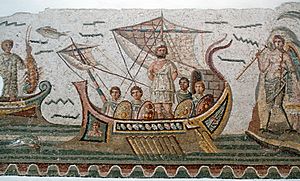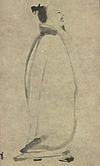History of literature facts for kids
The history of literature is about how people started writing down stories, poems, and other works. These writings were made to entertain, teach, or share ideas. Not all writings are literature. For example, a shopping list is not literature. This article focuses on how literature, as we know it, grew over time.
Contents
- Ancient Times (Bronze Age to 5th Century)
- Post-Classical Era (5th Century to 15th Century)
- Early Modern Era (15th Century to 18th Century)
- Late Modern Era (18th Century to 20th Century)
- Contemporary Literature (20th Century to 21st Century)
- See also
Ancient Times (Bronze Age to 5th Century)
Early literature came from stories told aloud by hunter-gatherer groups. These stories included myths and folk tales. Storytelling helped early humans share information and learn about dangers or how to behave in their group. Myths helped people understand the world around them. Long narrative poems called epic poems were very important in ancient times. These poems told about the amazing adventures of heroes, often from the early history of a nation.
Writing started in different parts of the world at different times. It began in Mesopotamia around 3200 BC, in Ancient China around 1250 BC, and in Mesoamerica around 650 BC. At first, writing was used for simple things like keeping records. Some of the oldest surviving literature includes The Maxims of Ptahhotep from Ancient Egypt and Classic of Poetry from Ancient China.
Literature in Mesopotamia
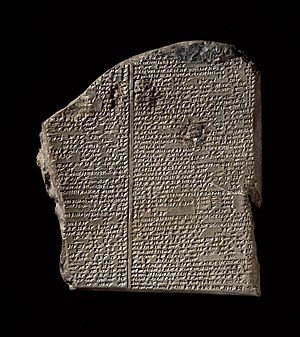
The oldest known literature comes from Sumer, a region in Mesopotamia. All Sumerian literature had parts that were like poetry. Sumerian poems used basic poetry elements like lines, pictures in words (imagery), and comparisons (metaphors). Characters could be humans, gods, talking animals, or even objects. Sumerian stories had both exciting parts and funny parts. These stories were mostly told aloud, but scribes also wrote them down. Some works were performed with music. Sumerian works did not have titles. People called them by their first line.
Later, Akkadian literature grew in places like Babylonia and Assyria. This happened from about 3000 BC to 1000 BC. Akkadian literature spread to other areas, including Egypt. The Akkadian language was influenced by Sumerian. Many Sumerian story ideas were used in Akkadian literature. Kings often asked scribes to write these works. Some celebrated the king or gods. Others recorded information for religious or medical uses. Akkadian literature included poems, proverbs (wise sayings), folk tales, love songs, and stories about arguments.
Literature in Ancient Egypt
Literature in the Old Kingdom of Egypt grew from everyday uses. Lists of gifts for gods became prayers. Records about government officials turned into autobiographies (stories of their own lives). These autobiographies showed the good qualities of the person. They often mixed prose (normal writing) and poetry. Kings were not written about much, except in official records. But poems were performed at royal funerals as part of religious events. Instructions were popular wisdom writings. They taught important ideas about Egyptian philosophy and religion.
These writing styles continued in the Middle Kingdom of Egypt. Autobiographies became more detailed. Kings played a bigger role in literature. Royal testaments (wills) were written from the king's view to his successor. Stories and advice about strong leaders were added to autobiographies and Instructions. Fiction and ideas about good and evil also developed. In the New Kingdom of Egypt, wisdom literature was still popular. But stories were used more than long discussions. Entertainment literature was popular among rich people. It included myths, folk tales, religious songs, love songs, and praise for the king and cities.
Literature in Ancient China
Zhou Dynasty Literature
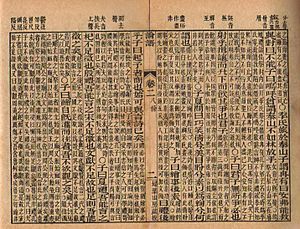
Chinese mythology was important in early Chinese literature. However, it was less central than in other cultures. By the Zhou dynasty, Chinese culture focused on the community, not just individuals. This meant fewer myths about powerful people or gods. Mythological stories were more common in the southern Chu region. The Tao Te Ching and the Zhuangzi are philosophical books. They are the basis of Taoism. Confucius was a key figure in ancient Chinese philosophy. He gathered the Six Classics as main texts for Confucianism. These became central for judging other Chinese writings. Confucianism shaped literary tastes in Ancient China from the Warring States period. Confucius's sayings were later put together in the Analects by his students.
Collections of writings (anthologies) were common in Ancient China. This helped decide which works were classics. The Classic of Poetry, one of the Six Classics, is the oldest Chinese poetry collection. It has 305 poems by unknown writers from 12th to 7th centuries BC. Before this, Chinese poetry was mostly spoken. The Chu Ci is another collection of poems from the Warring States period. These poems were meant to be recited with a special tone, not sung. The Music Bureau was created during the Zhou dynasty. It was a government group that collected musical works and folk songs. This role continued throughout Chinese history.
Historical documents also became a type of literature during the Warring States period. Records were combined with stories and sometimes legends. Two of the Six Classics, the Book of Documents and the Spring and Autumn Annals, are historical documents. The Spring and Autumn Annals inspired historical commentaries. These became their own type of writing. Examples include the Zuo Zhuan. The Zuo Zhuan is seen as the first large story work in Chinese literature. The Art of War by Sun Tzu was an important book on military strategy. People still read it today.
Qin and Han Dynasties Literature
Poetry from the short Qin dynasty is all lost. Poetry in the Han dynasty changed. Different styles appeared, like short poems and rhymed poems. Idealism also became popular. The Nineteen Old Poems were written then. Poetry in this time changed from four-word lines to five-word lines. The ballads (songs) of Chu became very popular across China. They often focused on ideas of fate.
Political writings by government officials were common in Chinese prose. But even these often used poetic language and metaphors. Jia Yi was an essay writer known for his emotional political writings. Chao Cuo wrote detailed, less emotional essays. Confucianism still guided philosophical works. But some writers, like Wang Chong in his Lunheng, started to criticize how Confucianism was used. Prose literature for entertainment also grew. Historical writing changed greatly with the Records of the Grand Historian. This was the first general history of ancient times. It was the largest literary work up to that point.
Six Dynasties Literature
During the Six Dynasties period, central power weakened. Confucianism lost some of its main influence. This led to many local philosophical writings. These included Taoist and Buddhist ideas. Prose fiction during the Wei and Jin dynasties was mostly supernatural folk tales. This continued in the Northern and Southern dynasties. Another type of prose was collections of short stories or impressions. Only A New Account of the Tales of the World survives.
Jian'an poetry grew from earlier styles. It used unique ideas and strong feelings to show individualism. Cao Cao, a ruler of China, led this movement. His poetry included songs performed with music. The Seven Sages of the Bamboo Grove were important poets in the Wei dynasty. They wrote about politics and philosophy in their poems. Chinese poetry developed a lot during the Jin dynasty. It used parallelism (repeated structures), rhythm, and showed feelings through nature. Zhang Hua and Lu Ji were great poets who developed early Western Jin poetry. In Eastern Jin, philosophical poetry became very abstract. Guo Pu and Tao Yuanming were notable poets in Eastern Jin.
Literary poetry and aestheticism (focus on beauty) became more popular in the Southern dynasties. Literature as art was seen as different from political or philosophical writing. This led to more literary criticism. The Literary Mind and the Carving of Dragons was written then. The Sixteen Kingdoms in the Northern dynasties had little cultural growth because they were unstable. Northern literature was often influenced by the Southern dynasties. Shanshui poetry (landscape poetry) also became important.
Literature in the Levant
Ancient literature from the Levant was written in Northwest Semitic languages. These include Aramaic and Canaanite languages like Phoenician and Hebrew. Many ancient writings (inscriptions) on stone, pottery, and ornaments are the main sources for understanding the writings of the ancient Phoenicians, Hebrews, and Arameans. These range from simple names to full texts.
The books of the Hebrew Bible developed over about 1,000 years. The oldest parts are from around the 11th or 10th centuries BCE. They are collections of different sources carefully put together. Many scholars believe the Hebrew Bible was finalized around the 3rd century BC. The New Testament was a later collection of books. It added to the Hebrew Bible. It includes the gospels (stories about Jesus) and letters (epistles) written by important early Christians.
Classical Literature (Ancient Greece and Rome)
Ancient Greek Literature
Early Greek literature used a specific poetic rhythm called dactylic hexameter. Homer is famous for creating epic poetry in Ancient Greece with the Iliad and the Odyssey. Hesiod developed a style of poetry based on lists and family trees, like the Theogony. Other important religious writers existed, but their works are now lost. Later, Sappho was a famous Greek poet. She helped develop lyric poetry (poems that express feelings).
Ancient Greek plays started in Athens in the 6th century BC. They were part of honoring Dionysus, the god of theater and wine. Greek plays used "elaborate costumes, complex choreography, scenic architecture, and the mask." They often had three tragedies followed by a satyr play (a funny play). Aeschylus, Sophocles, and Euripides were known for their tragedies. Aristophanes and Menander were known for their comedies. Sophocles is most famous for his play Oedipus Rex. It is an early example of irony in literature.
Ancient Greek philosophy became the basis of Western philosophy. Thales of Miletus was the first recorded Western philosopher. Plato advanced Greek philosophical literature. He put philosophical debates into dialogues (conversations) using Socratic questioning. Aristotle, Plato's student, wrote many works on different sciences. Aristotle also developed early literary criticism and theory in his Poetics.
Ancient Roman Literature
In the Roman Republic, literature included tragedy, comedy, epic poems, and historical works. Livius Andronicus is seen as the first to write literature in Latin. Because of Rome's power, Latin literature spread beyond Rome itself. Plautus was an important playwright. He was known for his comedies that focused on humor and popular culture. The late republic saw the rise of Augustan literature and Classical Latin. This was mostly prose, including works by Cicero. When the Roman Empire formed, political commentary decreased. Prose became less popular, replaced by poetry. Poets like Virgil, Horace, and Ovid brought about the Golden Age of Latin literature. Virgil's epic poem, the Aeneid, followed Homer's style closely.
Important Latin authors during the early empire included Pliny the Elder and Emperor Marcus Aurelius. As the Roman Empire grew, Latin literature increasingly came from Spain and North Africa. Historical works of the early empire included the epic Pharsalia by Lucan. It followed Caesar's civil war. The Annals of Tacitus recorded events of the first century. The Golden Ass by Apuleius was written later in the Empire. It might be the world's oldest novel. When Christianity was adopted in the Roman Empire, it appeared in Latin literature. This is most clear in the confessional writings of Augustine of Hippo, like his Confessions.
Ancient Indian Literature
India's knowledge traditions passed down philosophical and religious ideas through two ways: Shruti (that which is learned) and Smriti (that which is experienced). These included the Vedas. The Puranas are generally thought to be the earliest philosophical writings in Indian history. However, linguistic works on Sanskrit existed earlier than 1000 BC. Puranic works like the Indian epics, Ramayana and Mahabharata, have influenced countless other works. These include Balinese Kecak and shadow puppetry. Pali literature was important in the rise of Buddhism. Classical Sanskrit literature flourished in the Maurya and Gupta periods, from about 2nd century BC to 8th century AD. Classical Tamil literature also appeared early, from 300 BC to 300 AD. It is India's earliest non-religious literature, mainly about love and war. The Gupta period saw the rise of Sanskrit drama, classical Sanskrit poetry, and the collection of the Puranas.
Post-Classical Era (5th Century to 15th Century)
Medieval European Literature
After the fall of Rome (around 476 AD), many Greek and Roman writing styles became less popular in Europe. For about 1,000 years, until the Florentine Renaissance, medieval literature focused more on faith. This was partly because many Greek works were not saved in Europe. Muslim scribes, however, carefully preserved and copied many Greek works. The few classical works that remained in Europe changed. New styles grew from these changes. Some of these new styles can be seen in literature known as Matter of Rome, Matter of France, and Matter of Britain.
Around 400 AD, the Prudenti Psychomachia started the tradition of allegorical tales (stories with a hidden meaning). Poetry thrived with the troubadours. Their courtly romances and chanson de geste (songs of heroic deeds) entertained the upper classes who supported them. The First Crusade in 1095 also affected literature. For example, the image of the knight changed. The Islamic focus on science and saving Greek philosophical writings also influenced European literature.
Hagiographies, or "lives of the saints", were common in early medieval Europe. Writings by Bede, like his Historia ecclesiastica gentis Anglorum, continued a faith-based historical tradition. Religious writers had many aspects of Christianity to explain. Thomas Aquinas turned theology (the study of religion) into a kind of science. He was greatly influenced by Aristotle's works, which returned to Europe in the 13th century. Playwriting mostly stopped, except for mystery plays and passion plays. These plays focused on teaching Christian beliefs to common people.
Latin continued to be used as a literary language in medieval Europe. It was learned and used through literature. Scientific literature was usually written in Latin. Christianity became more important in medieval European literature, also written in Latin. Religious literature in other languages grew in the 13th century. This was for people who did not know Latin. Women, especially, were not allowed to learn Latin. Many religious works in various languages were written by women at this time.
Medieval English Literature
Early Medieval literature in England was written in Old English. This language is very different from modern English. Works from this time include the epic poem Beowulf and Arthurian fantasy stories about King Arthur. Literature in modern English began with Geoffrey Chaucer in the 14th century. He is known for The Canterbury Tales.
Medieval Italian Literature
The Decameron by Giovanni Boccaccio was published in 1351. It influenced European literature for centuries. Its structure, where ten people tell ten stories, introduced the term novella (a short novel). It inspired later works, like Chaucer's Canterbury Tales.
Islamic World Literature
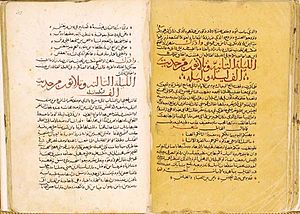
The most famous fiction from the Islamic world was The Book of One Thousand and One Nights (also called Arabian Nights). This was a collection of many older folk tales. The epic took shape in the 10th century and was finished by the 14th century. The number and types of tales changed between different copies. Many Arabian fantasy tales were called "Arabian Nights" when translated into English. This was true even if they were not in The Book of One Thousand and One Nights. This epic has been very influential in the West since it was translated in the 18th century. Many similar stories were written, especially in France.
Dante Alighieri's Divine Comedy, a great Italian epic, took many ideas about the afterlife from Arabic works. These included the Hadith and the Kitab al-Miraj (translated into Latin in 1264). This book was about Muhammad's journey to Heaven. The Moors (Muslim people from North Africa) also influenced works by George Peele and William Shakespeare. Some of their plays had Moorish characters, like Shakespeare's Othello. These works may have been inspired by Moorish groups visiting Elizabethan England in the early 17th century.
Arabic Literature
Ibn Tufail and Ibn al-Nafis were early writers of philosophical novels. Ibn Tufail wrote the first fictional Arabic novel, Hayy ibn Yaqdhan. Ibn al-Nafis then wrote Theologus Autodidactus. Both novels had main characters who were wild children living alone on a desert island. These are early examples of desert island stories. While Hayy stays on the island, Kamil's story in Theologus Autodidactus goes beyond the island. It becomes an early example of a coming of age story and a science fiction novel.
Theologus Autodidactus included science fiction ideas like spontaneous creation and the end of the world. Ibn al-Nafis tried to explain these events using the scientific knowledge of his time. This included biology, astronomy, and geology. His main goal was to explain Islamic religious teachings using science and philosophy through fiction.
A Latin translation of Ibn Tufail's work appeared in 1671. English, German, and Dutch translations followed. These translations later inspired Daniel Defoe to write Robinson Crusoe. This book is a candidate for the "first novel in English". Philosophus Autodidactus also inspired Robert Boyle to write his own philosophical novel set on an island. The story also has similarities to Mowgli's story in Rudyard Kipling's The Jungle Book and Tarzan's story. In these, a baby is abandoned but cared for by animals. Among other new ideas in Arabic literature, Ibn Khaldun wrote history by rejecting supernatural explanations. He basically invented a scientific way to study history.
Persian Literature
Ferdowsi's Shahnameh, the national epic of Iran, is a mythical and heroic retelling of Persian history. It is the longest epic poem ever written. From Persian culture, the book most famous in the West is the Rubaiyat of Omar Khayyam. This is a collection of poems by the Persian mathematician and astronomer Omar Khayyám. "Rubaiyat" means "quatrains," which are verses of four lines. Amir Arsalan was another popular mythical Persian story. It has influenced some modern fantasy fiction.
Early Persian proto-science fiction includes Al-Farabi's Opinions of the residents of a splendid city. This book was about a perfect society (utopia). It also had elements like the flying carpet.
Mid-Imperial China Literature
Sui and Tang Dynasties Literature
Lu Sidao and Yang Su were important poets of the early Sui dynasty. Yang moved away from the common Southern poetry styles. In the Sui and early Tang dynasties, emperors supported literature. They ordered many works and wrote some themselves. Poetry in this period followed the Palace Style. Then it changed with the work of the Four Paragons of the Early Tang. Wang Changling and Li Bai are seen as great poets of the High Tang. Landscape poetry and frontier poetry were important during the Tang dynasty. Tang poetry also included cí, a type of lyric poetry (poems expressing feelings). Chinese poetry focused more on politics, human suffering, and realism in the mid-Tang dynasty. This can be seen in the works of Du Fu. Chinese poetry split into two schools in the early 9th century. Poets like Meng Jiao wrote about unusual things. Poets like Bai Juyi focused on simplicity. The last years of the Tang dynasty saw the rise of lyric poetry. Li Shangyin and Wen Tingyun were important poets then.
Fictional stories became important in the Tang dynasty. They had fewer rules about form and length. Fiction in the mid-Tang period focused on social issues and romantic love. Important authors included Shen Jiji. Collections of stories became more common in the Late Tang period. These included chivalrous (heroic) tales by authors like Pei Xing. Popular literature included transformation texts, folk stories, and songs. The style of prose (normal writing) was not well developed at first. Parallel prose was popular in the early Tang dynasty. But writers like Li Bai moved away from strict forms. Han Yu promoted using classical prose, like ancient Confucian works. Printing began in Tang dynasty China. A copy of the Diamond Sutra, a Buddhist text, found in a cave, is the oldest known dated printed book (868 AD). It used block printing.
Song and Jin Dynasties Literature
Printing first became widespread in the Northern Song dynasty. Northern Song lyric poetry was developed by Yan Shu and Liu Yong. It became a popular hobby for common people. Ouyang Xiu developed the popular style of lyric poetry. Lyric poetry was different from the more formal shi poetry. Shi poetry followed traditional forms and was used by scholars. Political pressures strongly influenced the poetry of scholars in the Northern Song. Being good at older styles was needed for scholars to work in government. Politics and Confucianism especially influenced poetry. Poets like Mei Yaochen developed the poetry style used in the Middle Northern Song. Ouyang Xiu was an important literary scholar. He refined the main literary style of the time. Su Shi is said to have perfected it.
Chen Yuyi defined the style of Early Southern Song poetry. Lu You was a poet in the Middle Southern Song. He wrote a lot about political life and frustration with the dynasty's weak position in the Jin–Song Wars. Xin Qiji was another Middle Southern Song poet who wrote on similar topics from a military view. Poetic style did not change much in the Late Southern Song. But Yan Yu's Canglang Shihua was important for poetic theory. Classical poetry in the Early Jin focused on emotion. Later in the Jin dynasty, elegance was emphasized.
Popular fiction was usually performed in the Song dynasty. It was mostly short stories and historical tales. Classical prose fiction in the Song dynasty often used plain language and moral lessons. Zaju plays developed during the Song dynasty. They were a type of variety show that led to drama. The scientist Shen Kuo wrote the Dream Pool Essays (1088). This large science book included the oldest description of the magnetized compass. During the Song dynasty, there was also the huge historical work, the Zizhi Tongjian. It was compiled into 294 volumes by 1084 AD. The Jin dynasty saw advances in popular literature, including Romance of the Western Chamber.
Yuan Dynasty Literature
Drama developed greatly as a literary form in the Yuan dynasty. It made up much of the fictional works of that time. Variety plays were important in the Early Yuan period. Khanbaliq (modern-day Beijing) was the cultural center for these plays. As the 14th century began, variety play writers moved to Hangzhou. However, variety plays declined and did not reach the same importance. The nanxi was developed as a type of play at the same time. It showed the unique political life of the Yuan dynasty. Tale of the Pipa by Gao Ming was an important nanxi drama. Qu was a common type of poetry in the Yuan dynasty. It was used both alone and as part of plays.
Two of the earliest Chinese novels, Romance of the Three Kingdoms and Water Margin, first appeared in the Yuan dynasty. Poetry in the Yuan dynasty remained the main way for classical writers to express themselves. But the Song tradition of intellectual poetry was replaced by poetry that showed strong emotion. Northern Yuan poetry was influenced by Yuan Haowen. Southern Yuan poetry was influenced by Yan Yu.
Classical and Feudal Japanese Literature
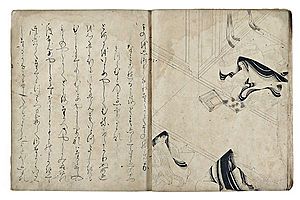
Classical Japanese literature usually means works from the Heian period. Japanese literature first became different from Chinese literature around the 8th century. Fudoki were 8th-century records. They were usually written in Chinese and documented both historical and mythological stories. Folk ballads were also common. These were meant to be chanted and often had a specific syllable structure. The tanka was especially highly regarded. Writing waka poetry became more important in the Heian period. It was a necessary skill for rich people in social settings and for courtship. The iroha poem, which sets an order for Japanese syllables, was also written in this period.
The Man'yōshū is the oldest collection of Japanese poetry. It was written in Japanese using Chinese characters. It collects waka poetry from the 5th to 8th centuries. The Kokin Wakashū was a collection of 9th-century waka poetry ordered by the emperor. While the Man'yōshū had poems from different classes, the Kokin Wakashū only had poems from aristocratic poets. The Tales of Ise is a collection of poems and stories based on the life of Ariwara no Narihira. The Tale of the Bamboo Cutter is an early example of proto-science fiction. It was written in the 10th century. The main character is a princess from the Moon. An illustration shows a disc-shaped flying object like a flying saucer.
Utsubo Monogatari and Ochikubo Monogatari were early prose works from the 10th century. They showed the lives of rich people realistically. The former is sometimes seen as the first novel. At the same time, aristocratic women started keeping diaries about their lives. The Tale of Genji was the next major prose work in Japan. It was written in the 11th century. Its use of realism and romantic ideas inspired later prose fiction from the Heian period. These included historical works and romantic novels. While these stories usually showed rich people, Konjaku Monogatarishū was written in the 12th century. It collected about a thousand stories from different walks of life in Japan, China, and India. Japanese literature expanded beyond the rich in the 13th century. It became more available to lower classes. This often happened through religious texts narrated by blind priests, like The Tale of the Heike. In the 14th and 15th centuries, poetry like renga and drama like noh and kyōgen were written by professional writers. They were supported by the court, temples, or local lords.
Southeast Asian Literature
The literature of Java and the Kawi language is best known for kakawin poetry. These were narrative poems based on Sanskrit poetry traditions. They often included religious elements. The oldest surviving kakawin is Kakawin Ramayana from the 9th century. It is a Javanese version of the Sanskrit Bhaṭṭikāvya.
Pre-Columbian Mesoamerican Literature
Mesoamerican literature was usually written on codices (ancient books). Most surviving codices were written in the Latin alphabet after colonization to save oral traditions. Nahuatl literature was divided into cuícatl (song and poetry) and tlahtolli (prose works like history and speeches). The teocuícatl were divine hymns sung to praise the gods. Other Nahuatl poetry celebrated life and friendship, honored warriors, or asked philosophical questions. King Nezahualcoyotl of Tetzcoco was a notable poet and songwriter.
Literature in the Mayan languages was closely linked to oral tradition. Writing helped guide memorized passages that were often performed. It was very symbolic and used a lot of wordplay. Metaphors and images of nature were common. Mayan literature was often religious. It included information on religious practices, fortune-telling, and the gods. Much of this literature was later destroyed by Christian priests. The Dresden Codex, the Paris Codex, and the Madrid Codex are the only surviving pre-Columbian Mayan codices. Important surviving Mayan texts include the Popol Vuh, the Chilam Balam, and the Annals of the Cakchiquels. These describe the religious beliefs of Mesoamerican cultures.
Early Modern Era (15th Century to 18th Century)
Early Modern European Literature
The Renaissance covered much of European culture during this time. This period saw a new interest in the classical works of Ancient Greece and Rome. There was also a lot of artistic and scientific progress. Literature, like most arts, was paid for by rich nobles. Writing fiction was not seen as a job itself. It was usually done by people who were already wealthy. The invention of the printing press in the mid-15th century changed European literature greatly. Printed books allowed for more consistency in works and helped literacy spread. Religious literature was especially affected. Churches funded and were involved in printing. Literary criticism also grew as works became more available.
The type of writing common today—the novel—started in the early modern period. It became more popular in the next century. Before the modern novel became established, there was a stage where "newness" appeared in epic poems. Petrarch made the sonnet a popular poem form. Giovanni Boccaccio's Decameron made romance acceptable in prose as well as poetry. François Rabelais brought new life to satire with Gargantua and Pantagruel. Michel de Montaigne invented the essay and used it to record his life and ideas. Perhaps the most important work of the time was a book printed in Nuremberg. It was called De Revolutionibus Orbium Coelestium. In it, the astronomer Nicolaus Copernicus said the Earth was not the center of the universe. This had big effects on science, literature, and how people thought about humanity and truth.
Plays for entertainment returned to Europe's stages. William Shakespeare is the most famous early modern playwright. Many others made important contributions, including Molière and Christopher Marlowe. From the 16th to 18th century, Commedia dell'arte performers improvised in the streets of Italy and France. Some of these plays were written down. Both the written plays and the improvisation influenced literature, especially Molière's work. Shakespeare used the skills of jesters and traveling performers to create new comedies. All parts, even female ones, were played by men. But this changed in France and England by the end of the 17th century.
British Literature
As England became a world power, English literature focused on England itself. This started with The Faerie Queene by Edmund Spenser. It was written in the 1590s to honor Queen Elizabeth I. Metaphysical poetry developed in the 17th century. It was led by John Donne, known for his love poems. The Augustan literature movement grew in the 18th century. Led by Samuel Johnson, it tried to copy the classical styles of Ancient Greece and Rome. Augustan critics disliked metaphysical poetry for being too lighthearted. John Milton wrote the epic poem Paradise Lost. He wanted to create an English Christian epic that could rival Homer and Virgil. During Oliver Cromwell's rule in the 1650s, arts were restricted by Puritan ideas. This censorship helped lead to the fall of the Commonwealth of England and the return of the British monarchy. Under the restored monarchy, arts were freer. King Charles II supported theater.
William Shakespeare was a famous playwright in the late 16th and early 17th centuries. He is seen as the greatest author in the English language. He is known for his comedies, dramas, and histories. He also used blank verse (poetry without rhyme), sonnets (14-line poems), and soliloquy (a character speaking their thoughts aloud). Shakespeare's historical plays did not always follow history exactly. They often thought about royal succession, reflecting concerns about Elizabeth I's successor. Early English novels include The Pilgrim's Progress by John Bunyan and Oroonoko by Aphra Behn. Both were published in the 1680s. Bunyan introduced ideas of individualism and the search for personal happiness. Behn used her writing to criticize society, questioning the Atlantic slave trade. Robinson Crusoe by Daniel Defoe is considered the first modern English novel. It celebrated the social mobility (ability to move up in society) brought by capitalism. The book was written in a realistic style. The first edition was sold as a true autobiography, without mentioning Defoe as the author. Jonathan Swift brought the fantasy novel to English literature. His most famous is Gulliver's Travels, also marketed as a true story.
French Literature
Gargantua and Pantagruel was written by François Rabelais in five parts in the mid-16th century. It was an early influence on the novel. It used an informal style and funny, rebellious humor.
The 17th century in France is known as the Grand Siècle (Great Century). The most famous French authors, besides playwrights, include Jean de La Fontaine and Charles Perrault. They are known mainly for their fables (short stories with a moral).
Italian Literature
The Italian Renaissance was the start of what would become the European Renaissance.
The earliest work considered an opera (a play set to music) dates from around 1597. It was Dafne (now lost). It was written by Jacopo Peri for a group of educated people in Florence called the "Camerata".
Spanish Literature
Don Quixote by Miguel de Cervantes was published in the early 17th century. It is seen as an early novel. It was a picaresque novel (about a clever, low-class hero) that made fun of chivalric romance (stories about knights). The 16th and 17th centuries are known as the Spanish Golden Age.
Early Modern East Asia Literature
Qing Dynasty Literature
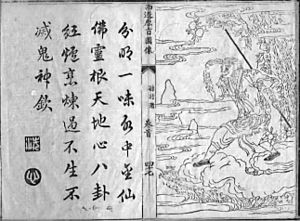
Printing became very important in China during the Ming dynasty in the early 16th century. By this time, many people in cities could read. This was helped by the availability of paper. Written works were put into four groups: classics, histories, philosophy, and belles-lettres (beautiful writing). Among common people, songs were popular. They were often performed by entertainers. Literature was controlled by the Ming dynasty's first emperor, Hongwu Emperor. Writers who did not follow his rules were killed. This led to a decline in Chinese literature in the 14th and 15th centuries. Jiandeng Xinhua by Qu You was a collection of supernatural stories. It was one of the few works that remained popular despite the control. Variety plays were the most common type of drama in the Early Ming period. Prince Zhu Youdun was the most important playwright. A literary revival happened in the Middle Ming period. Poetry revived, led by groups like the Four Talents of Suzhou. Early Chinese novels developed then, including Water Margin, Romance of the Three Kingdoms, and Journey to the West.
In the Late Ming period, literature focused more on the role of individuals in society. This started with the works of Li Zhi. Chinese philosophy developed humanist ideas. These challenged being completely obedient to community and imperial power. The Gong'an School produced literature that favored natural feelings and simplicity. The Jingling School was a response to the Gong'an School. It accepted "natural sensibility" but rejected the carefree style. Novels became more common in the Late Ming period as book publishers appeared. Jin Ping Mei is a great novel of the Late Ming period. It was the first novel to show the daily life of common people. Huaben stories were also common. Dramas became more common as rich people liked to entertain guests with private theater groups. Tang Xianzu was an important playwright.
Japanese Literature
Wood block printing became popular in the 17th century. Over a thousand books were sold each year by 1670. By the 17th century, social groups separated drama. Samurai watched noh plays. Chōnin (townspeople) watched kabuki. Writers often worked for the government, a specific family, or lived a quiet life. Ishikawa Jōzan was an important 17th-century poet.
Korean Literature
Korean literature became different from Chinese literature in the Joseon dynasty. The akjang, the sijo, and the gasa were popular types of lyric poems. Yongbieocheonga was a major collection of poems from the 1440s. Korean stories in the common language were developed by Heo Gyun in the early 17th century with Hong Gildong jeon. This book's structure was used to create heroic fiction. The Cloud Dream of the Nine was written by Kim Man-jung. It showed historical and philosophical changes using a dream structure. Pansori fiction developed in the early 18th century.
Late Modern Era (18th Century to 20th Century)
Late Modern European Literature
The 18th century was the Age of Enlightenment. Its most important authors were Voltaire, Jean-Jacques Rousseau, and Immanuel Kant. The second half of the century saw the start of Romanticism with Goethe. In the later 19th century, Romanticism was challenged by Realism and Naturalism. The late 19th century, known as the Belle Époque, seemed like a "golden age" of European culture. It ended with the start of World War I in 1914. Modernist literature was written from about 1900 to 1940.
In Britain, the 19th century was dominated by the Victorian era. This time was known for Romanticism. There were Romantic poets like William Wordsworth and Lord Byron. Genres like the gothic novel were popular. Charles Dickens, perhaps the most famous novelist in English literature, was active then. He helped the novel become the leading literary type in Victorian England.
In Denmark, the early 19th century Golden Age produced many writers. These included Søren Kierkegaard and Hans Christian Andersen.
In Germany, the Sturm und Drang period of the late 18th century led into a Classicist and Romantic period. This was best shown by Goethe's long career, covering the first third of the century. The conservative Biedermeier style clashed with the radical Vormärz in the time between the Napoleonic wars and the Revolutions of 1848.
United States Literature
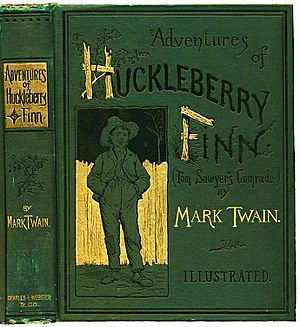
Literature of the American Revolution included A Summary View of the Rights of British America by Thomas Jefferson and Common Sense by Thomas Paine. The Power of Sympathy by William Hill Brown was the first American novel. It was written in a realistic style with a clear moral message. Judith Sargent Murray is credited with starting American feminism through her essays and poetry. The United States quickly achieved widespread literacy in the early 19th century. Many authors made fiction writing their main source of income. Washington Irving set the example for comic literature and short stories. He started the Knickerbocker School, which wrote fondly of New York. James Fenimore Cooper similarly set the example for American sea stories, novels about manners, political satire, and frontier stories. Edgar Allan Poe was very influential in fiction, poetry, and essays. He is especially known for his contributions to Gothic fiction and mystery fiction. Nathaniel Hawthorne wrote moralistic stories like The Scarlet Letter, inspired by colonial-era Puritan literature. Herman Melville explored human contradictions in sea stories like Moby-Dick. However, his work did not become influential until the 1920s. William Cullen Bryant was called the "founding father of American poetry." Walt Whitman is celebrated for capturing the essence of America in his poetry collection Leaves of Grass. Emily Dickinson was not published during her lifetime, but her works were later praised.
Transcendentalism grew as a philosophical school in the early 19th century. Authors like Ralph Waldo Emerson contributed to transcendentalist literature. Many works were written about slavery in the early United States. These included Uncle Tom's Cabin by Harriet Beecher Stowe. Freed slaves like Frederick Douglass and Harriet Jacobs also wrote autobiographies. These promoted the cause of abolitionism (ending slavery). Native American literature in the early 19th century struggled between keeping traditional elements and adding parts of contemporary American literature. Realism and naturalism became popular in the United States in the late 19th century. Mark Twain gained wide fame for his novels, including Adventures of Huckleberry Finn. Regionalism developed, where different literary traditions grew in the West, Midwest, South, and New England. African American and Native American literature also grew as distinct traditions.
A movement against small-town and middle-class values appeared at the start of the 20th century. This included authors like Theodore Dreiser and Sinclair Lewis. Civil rights literature of the early 20th century was written by authors like W. E. B. Du Bois. American poetry expanded greatly in the 20th century. It introduced or included modernist poetry traditions like Imagism. Poets like Edwin Arlington Robinson and Robert Frost were important in developing poetic form. Authors like F. Scott Fitzgerald and Ernest Hemingway explored their place in American society through modernist novels. Authors like John Steinbeck looked for a future identity for the United States. Counter-movements appeared against modernism. The early 20th century also saw the rise of American drama that was different from Europe's. Popular genre fiction then included westerns and detective fiction.
Canadian Literature
Early Canadian novels adapted European literary trends. The History of Emily Montague was the first Canadian novel, published in 1769. The aftermath of the Seven Years' War greatly influenced Canadian literature in the 18th and 19th centuries. This was when French Canada was transferred to the British. Popular novels, like those by Julia Catherine Beckwith, appeared in the early 19th century. They focused on daily experiences rather than grand stories. Nature became very important in Canadian literature by the mid-19th century. Edward Hartley Dewart was an important figure in early Canadian poetry. He published the first Canadian poetry collection in 1864. He saw the creation of Canadian literature as part of a conflict between colonial origins and a unique Canadian identity. Octave Crémazie led the French Canadian literature movement in the 1860s. Notable Canadian poets of this period included Charles Sangster and the Confederation Poets. Victorian poetry remained important in Canada into the early 20th century. However, international modernist movements gained influence after World War I. Poets like Arthur Stringer led a free verse movement in the 1910s and 1920s.
Latin American Literature
Latin American literature became its own distinct tradition at the start of the 19th century. The main change was in the subject matter and themes, while the form remained quite European. It began with an individualist trend linked to the Latin American independence movements. Within this movement, each Latin American country developed its own literature as they formed national identities. Andrés Bello is seen as a founder of modern literature in Hispanic America. He is credited with making Romanticism popular in the region. The balance between national and continental literary identities was a major issue in early Latin American literature, especially in Spanish.
Late Modern East Asia Literature
Qing Dynasty and Republic of China Literature
The Qing dynasty saw the return of prose literature mainly for Confucian teaching. Individualist literature declined. The Three Masters of Jiangdong were the most important poets during the transition from Ming to Qing. Wang Shizhen led poetry trends in the Early Qing period. He expressed feelings through imagery and rhythm rather than complex words. Song lyrics also became popular again. Heroic fiction was adapted into popular novels. Supernatural fiction also became popular, including Strange Tales from a Chinese Studio by Pu Songling.
In the Middle Qing period, Shen Deqian and Yuan Mei each started new poetry trends. Pianwen became popular among prose writers. Six Records of a Floating Life was an autobiography by Shen Fu. It focused on direct language and emotional appeal. Performing arts included the northern guci drum lyric and the southern tanci strummed lyric. The latter was often written by women poets. Novels of the Middle Qing period included The Scholars and Dream of the Red Chamber. Both ignored popular taste for philosophy. Drama went out of fashion among the rich, but theatrical performances remained common for the public. In the Late Qing period, Western culture greatly influenced Chinese society. Chivalrous novels about folk heroes, political novels criticizing the falling Qing government, and genre fiction all became popular in the final years of the Qing dynasty.
Literature in the Republic of China showed the societal changes from the 1911 Revolution. Chinese literature broke away from classical tradition with the New Literature Movement in 1919. This started with works like Experiments by Hu Shih and Diary of a Madman by Lu Xun. The May Fourth Movement promoted using everyday Chinese in writing. Supporters of liberal reform in China backed these literary changes to challenge old imperial systems. These works usually supported humanism and individualism. A rejection of individualism appeared with the start of the Chinese Civil War. Revolutionary literature spread to support the Chinese Red Army.
Contemporary Literature (20th Century to 21st Century)
Contemporary literature is defined as literature written after the end of World War II in 1945. Postmodern literature was written from about 1945 to 1980. Popular literature developed its own genres like fantasy and science fiction. These genres, often ignored by mainstream literary critics, developed their own awards. Examples include the Nebula Award (since 1965) and the British Fantasy Award (since 1971).
|
See also
 In Spanish: Historia de la literatura para niños
In Spanish: Historia de la literatura para niños
- History of art
- History of books
- History of fantasy
- History of film
- History of ideas
- History of poetry
- History of science fiction
- History of theater
- History of writing
- Intellectual history
- Literature by country


